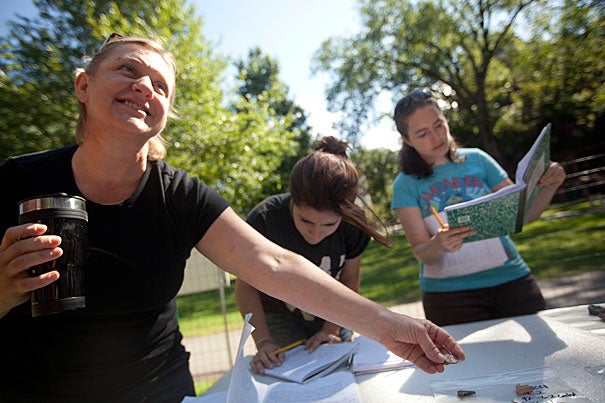
Students Colleen Skipper (from left), Julie Boshyk, and Cristina Monfasani record their findings during the Summer School’s Yard dig program’s “results day.”
Kris Snibbe/Harvard Staff Photographer
Digging in the Yard, it’s child’s play
Biennial summer dig unearths evidence of children at Harvard
Students digging for Harvard’s earliest roots in the Yard this summer have uncovered evidence of a group invisible in the public image of the male-dominated institution that Harvard was in the 1800s: children.
Students participating in the biennial Archaeology of Harvard Yard Summer School course unearthed a fragment of a doll’s head, one of the first indications of the presence of children at what, in the 1800s, was an institution where male students were taught by male faculty.
But class instructors Diana Loren, instructor in anthropology and associate curator in the Peabody Museum of Archaeology and Ethnology, and Christina Hodge, senior curatorial assistant at the Peabody, said that women were an important part of the Harvard community, albeit in support roles — cooking, cleaning, and doing laundry — so it makes sense that children were here as well.
With just a fragment to go on, though, the two said it’s impossible to know the doll’s exact history. While it might have belonged to the child of a woman working at Harvard, it could have just as easily belonged to a faculty member’s child or even to a child from the community playing in the Yard. Still, they said, it highlights the importance of archaeology as a way to understand not just the myth of Harvard, but the reality of the place for those who lived here every day.
“It’s unusual; we didn’t have anything related to children here,” Loren said. “That’s the untold story of 19th century Harvard.”
The course is the first part of what will be two classes digging in the Yard this year. The summer’s finds were displayed Wednesday (Aug. 3). After Summer School wraps up, Harvard College students will resume digging during the fall term. The ultimate goal is to reach the remains of what appeared to be a foundation trench of the Indian College uncovered during the last dig, in 2009.
The Indian College was among Harvard’s first buildings and an early fulfillment of the College’s original charter, dedicating the institution to educating colonial and Indian youths alike.
Students digging this summer uncovered a variety of items, including glass fragments, a door latch, building materials such as brick and slate from a roof, and more evidence of smoking on campus in the form of pipe stems and bowls.
Though the students’ limited time allowed them to dig only to layers dated to the 1800s, some of the materials uncovered were much older, including a pipe bowl dated to between 1620 and 1660, which likely became mixed with younger material during building activities on the site. In fact, Loren said, there is evidence of what was likely a trash pit on the site, since the soil is more lightly colored and artifacts and building materials appear to be jumbled in that location.
Students said they enjoyed the summer experience, which included research in the Harvard archives for a midterm paper about the life of a student from the 1700s or 1800s.
Colleen Skipper, who works in computer support at Harvard, said the class was the first time she had conducted archaeology. She enjoyed both the fieldwork and the archival research. The student she wrote about was at Harvard during the “butter rebellion,” a student protest during the 1700s over rancid butter served at meals.
“I thought it was brilliant,” Skipper said of the class experience.
Julia Boshyk, a student from McGill University, said she came to summer school at Harvard to get some hands-on experience, which, as an anthropology major, was particularly valuable to her.
“It’s a good introduction to field work,” Boshyk said.
Kathleen Milster, a medical technologist at Tufts Medical Center, said she is intrigued by both the history and by the personal stories that they’ve uncovered. During her archival work, she wrote about a student named John Page, whose diary she found in the Harvard archives.
“I love the stories, and I love the evidence of the people,” Milster said.




